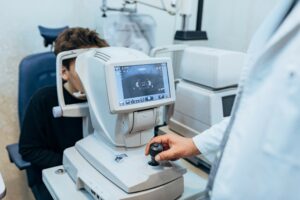January 1, 2024
By Thomas Naduvilath, Msc Biostatistics, PhD, Head of Biostatistics at BHVI
With the emphasis of myopia control to reduce axial elongation and its related ocular complications, it is necessary that axial length is routinely measured and compared over time to monitor myopia progression.

Photo Credit: Kosamtu, Getty Images
Traditionally, refractive error measurements are used to identify and monitor myopia. However, with the introduction of laser interferometric instruments to measure ocular biometry parameters, there is an increased impetus to use axial length measurements to monitor myopia.
Cycloplegic spherical equivalent refractive error of -0.50D is the definitive indicator of myopia onset, but absolute values of axial length are not used to determine onset. However, once myopia is established, measuring axial length to monitor progression has been highlighted as an essential requirement.1,2
Repeatable, Accurate Measurements
Axial length measurements can be consistently used and compared across all treatment strategies, which is impossible with refractive error measurements. Increasingly popular treatment strategies in the pediatric population include orthokeratology and low-dose atropine drops. Monitoring myopia progression using OrthoK is assessed exclusively using axial length measurement, as the treatment induces changes in the refractive components independent of axial length.3 Similarly, myopia control efficacy using pharmaceutical treatments such as atropine should ideally be monitored using axial length measurements, as expected correlation of refractive error change with axial elongation has not been consistently observed in previous studies.4
The advantages of measuring axial length benefit both optometrists and patients. Compared to historical ultrasound techniques, the current technology of optical low-coherence interferometry to measure axial length has clearly improved accuracy, reliability, and patient acceptance with its rapid and non-invasive methods.5 In comparison to refractive error measurements, the sensitivity of axial length measurements using current technology has been shown to be greater by a factor of three.1 The advantages of axial length instruments and measurements over refractive error has benefit particularly when examining the pediatric population who otherwise require cycloplegic assessment.
Following the Lead of Important Organizations
The shift towards axial length measurements clinically is further strengthened with the FDA listing both axial length change and refractive error change as primary effectiveness end points for clinical trials that assess myopia control devices, but the use of axial length is favored.6
Detailed analysis of increasing levels of myopia associated with vision-threatening complications such as myopic macular degeneration (MMD) reveals that axial length and not refractive error is a consistent predictive factor.7 Consequently, the International Myopia Institute’s (IMI’s) view that myopia control should be about the reduction of axial elongation (associated with posterior pole complications) further highlights the need to monitor the axial growth in myopic patients.2
Centile Charts Are A Beneficial Tool
Resistance to using axial length measurements may be related to the absence of standardized clinical guidelines that are broadly adopted for the use and interpretation of these measurements. To aid clinicians, researchers have developed population-specific percentile charts as a tool to monitor the risk and progression of myopia.8,9 These charts are useful to identify those experiencing higher than expected axial elongation, which is a function of age, gender, and ethnicity, and can assist with decision-making around commencement or alteration of myopia management strategies.10 Using a population-specific percentile chart, a child’s measured axial length when placed on an age specific curve provides a percentile rank relative to the reference population. Follow-up measurements can be used to monitor axial length growth or efficacy over time.
With the emphasis of myopia control to reduce axial elongation and its related ocular complications, it is necessary that axial length is routinely measured and compared over time to monitor myopia progression. Other advantages, such as improved precision and ease of use, are added and timely incentives to implement axial length measurements for myopia management.
 |
Thomas Naduvilath, Msc Biostatistics, PhD, is the Head of Biostatistics at BHVI and a Conjoint Associate Professor at the School of Optometry and Vision Science, University of New South Wales. |
References
- Brennan NA, Toubouti YM, Cheng X, Bullimore MA. Efficacy in myopia control. Prog Retin Eye Res. 2021 Jul;83:100923.
- Wolffsohn JS, Kollbaum PS, Berntsen DA, Atchison DA, Benavente A, Bradley A, et al. IMI – Clinical Myopia Control Trials and Instrumentation Report. Invest Ophthalmol Vis Sci. 2019 Feb;60(3):M132–60.
- Cheung SW, Cho P. Validity of Axial Length Measurements for Monitoring Myopic Progression in Orthokeratology. Invest Ophthalmol Vis Sci. 2013;54(3):1613–5.
- Yam JC, Jiang Y, Tang SM, Law AKP, Chan JJ, Wong E, et al. Low-Concentration Atropine for Myopia Progression (LAMP) Study: A Randomized, Double-Blinded, Placebo-Controlled Trial of 0.05%, 0.025%, and 0.01% Atropine Eye Drops in Myopia Control. Ophthalmology. 2019;126(1):113–24.
- Song JS, Yoon DY, Hyon JY JH. Comparison of Ocular Biometry and Refractive Outcomes Using IOL Master 500, IOL Master 700, and Lenstar LS900. Korean J Ophthalmol. 2020;34(2):126–32.
- Walline JJ, Robboy MW, Hilmantel G, Tarver ME, Afshari NA, Dhaliwal DK, et al. FDA Workshop: Controlling the Progression of Myopia: Contact Lenses and Future Medical Devices. Eye Contact Lens. 2018 Jul;44(4):205–11.
- Asakuma T, Yasuda M, Ninomiya T, Noda Y, Arakawa S, Hashimoto S, et al. Prevalence and risk factors for myopic retinopathy in a Japanese population: the Hisayama Study. Ophthalmology. 2012 Sep;119(9):1760–5.
- Tideman JWL, Polling JR, Vingerling JR, Jaddoe VW V., Williams C, Guggenheim JA, et al. Axial length growth and the risk of developing myopia in European children. Acta Ophthalmol. 2018 May;96(3):301–9.
- He X, Sankaridurg P, Naduvilath T, Wang J, Xiong S, Weng R, Du L, Chen J, Zou H XX. Normative data and percentile curves for axial length and axial length/corneal curvature in Chinese children and adolescents aged 4-18 years. Br J Ophthalmol. 2023;107(2):167–75.
- Klaver C, Polling JR. Myopia management in the Netherlands. Ophthalmic Physiol Opt J Br Coll Ophthalmic Opt. 2020 Mar;40(2):230–40.













